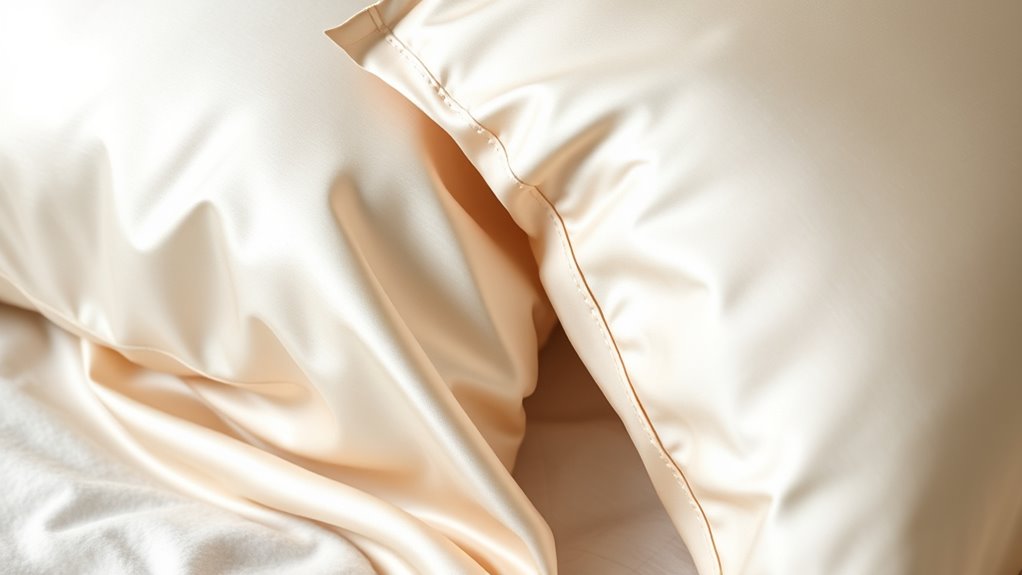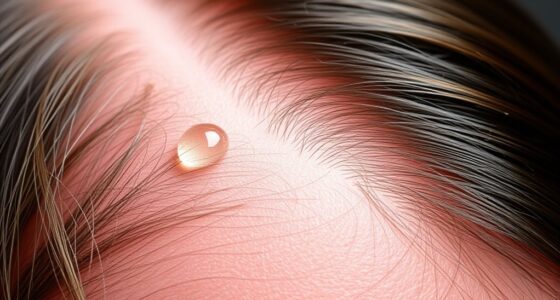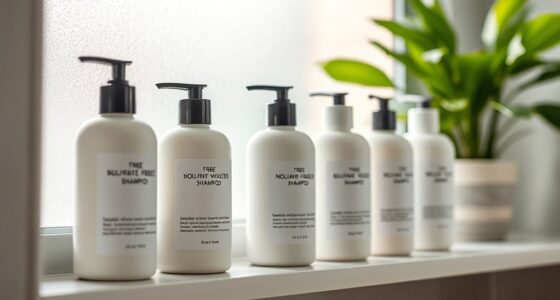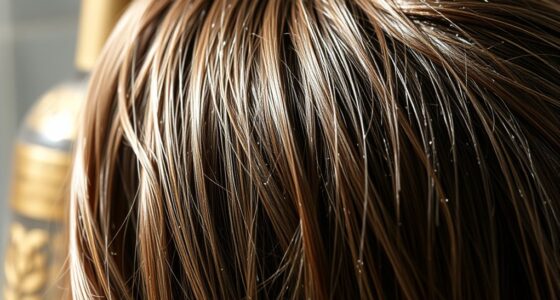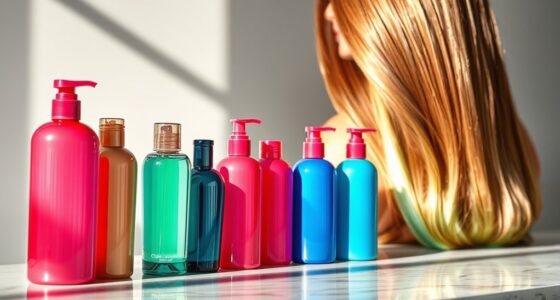Silk pillowcases are made from natural fibers, offering a smooth, hypoallergenic surface that reduces friction and minimizes hair breakage, frizz, and sleep lines. Satin, a fabric weave, can be made from silk or synthetic fibers; synthetic satin is often more affordable and durable but can trap heat and moisture. If you want long-term hair protection with natural, breathable material, silk is ideal. Keep exploring to discover which option best suits your needs.
Key Takeaways
- Silk pillowcases are made from natural, hypoallergenic fibers that reduce hair friction and prevent breakage and frizz better than satin.
- Satin, often synthetic, provides a shiny, smooth surface but may trap heat and moisture, potentially affecting hair health differently.
- Silk offers superior breathability and temperature regulation, helping maintain hair moisture and reduce sleep lines.
- Satin is more affordable, durable, and easier to care for, making it a practical choice for everyday use.
- Silk’s natural properties make it more effective long-term for minimizing hair damage compared to synthetic satin.
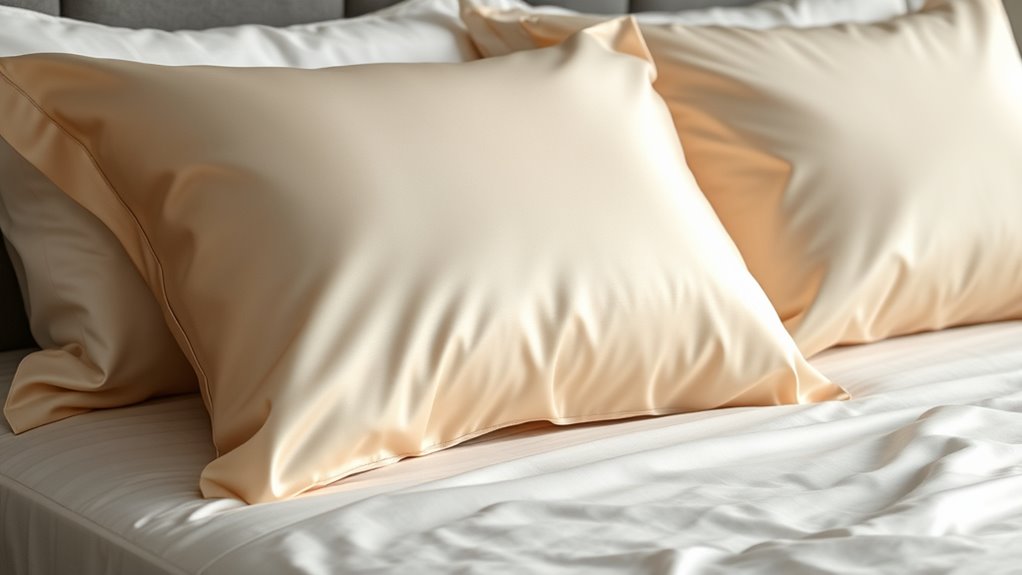
When choosing the perfect pillowcase, many people wonder whether silk or satin is the better option. Both materials are popular for their luxurious feel and potential benefits for your hair and skin, but they have distinct differences that can influence your choice. Silk is a natural fiber produced by silkworms, offering a smooth, breathable surface that can help reduce friction on your hair and skin. Satin, on the other hand, isn’t a fiber itself but a weave that can be made from various materials, including polyester, nylon, or silk. The term “satin” refers more to the fabric’s shiny, glossy surface and smooth texture rather than its composition.
Silk pillowcases are often praised for their natural properties. Because silk is a protein fiber, it tends to be more gentle on your hair and skin, helping to minimize frizz, breakage, and sleep lines. Silk’s smooth surface reduces the tugging and pulling that can happen with rougher fabrics, which is especially beneficial if you have curly or textured hair. Additionally, silk is hypoallergenic and resistant to dust mites, mold, and fungus, making it a good choice if you have allergies or sensitive skin. Its breathability also helps regulate temperature, keeping you cool in summer and warm in winter.
Silk pillowcases are gentle, hypoallergenic, and help reduce frizz and sleep lines.
Satin pillowcases, however, are usually more affordable and easier to care for, especially if made from synthetic fibers like polyester. While synthetic satin may not offer the same natural benefits as silk, it still provides a slick surface that reduces friction and prevents hair damage. Satin is also durable and can withstand frequent washing without losing its shine or smoothness, making it a practical choice for everyday use. However, synthetic satin can sometimes trap heat and moisture, which might lead to sweating or skin irritation for some people.
In terms of feel, silk offers a luxurious, soft touch that many find more pleasurable to sleep on. It’s lightweight and breathable, which contributes to a more comfortable night’s sleep. Satin, although smooth, can feel slightly heavier or shinier, depending on its quality and fiber content. While both materials help protect your hair from damage, silk’s natural properties make it marginally more effective at maintaining hair health over time. Ultimately, your choice depends on your priorities—whether you value natural, hypoallergenic qualities and a more authentic luxury feel or prefer affordability and ease of maintenance.
Frequently Asked Questions
Which Material Is More Eco-Friendly: Silk or Satin?
Silk is generally more eco-friendly than satin because it’s a natural, biodegradable fiber produced by silkworms, especially if sourced sustainably. Satin, often made from polyester or nylon, is synthetic and derived from petrochemicals, which have a higher environmental impact. By choosing silk, you support sustainable farming practices and reduce plastic waste. However, opting for certified organic silk guarantees even better eco-friendliness, making it a smarter choice for the environment.
Are There Specific Hair Types That Benefit More From One Material?
If you have curly, textured, or fragile hair, you’ll benefit more from silk because it reduces friction, prevents breakage, and maintains moisture. For straight or fine hair, satin offers smoothness and less static, helping your hair stay sleek and manageable. You notice fewer tangles and less damage with either material, but choosing the right one depends on your hair type and your hair goals for softness and health.
How Do Care Instructions Differ Between Silk and Satin Pillowcases?
You should hand wash silk pillowcases with gentle detergent and cold water, then air dry to prevent damage. Satin pillowcases are more durable and usually machine washable on a gentle cycle; just use cold water and mild detergent. Avoid bleach and high heat for both, as they can weaken fibers. Always check specific care labels, and consider using a pillowcase cover to extend their lifespan and keep them looking their best.
Can Satin Pillowcases Be Made From Synthetic or Natural Fibers?
Yes, satin pillowcases can be made from both synthetic and natural fibers. Synthetic options include polyester and nylon, which are affordable and durable. Natural fiber satin typically uses charmeuse made from silk or cotton. When choosing, consider your preferences for eco-friendliness, softness, and maintenance. Synthetic satin is easier to care for and more budget-friendly, while natural fiber satin offers a more luxurious feel and breathability.
Do Silk and Satin Pillowcases Affect Skin Health Differently?
Yes, silk and satin pillowcases can affect your skin health differently. Silk is naturally hypoallergenic, breathable, and gentle, reducing friction and skin irritation, which can help prevent wrinkles and acne. Satin, often made from synthetic fibers, may not offer the same benefits and could trap heat or cause irritation if it’s not high-quality. Choosing high-quality silk can support healthier, smoother skin, especially if you have sensitive or acne-prone skin.
Conclusion
In the battle of silk versus satin, remember that your choice shapes your hair’s story—like a gentle whisper of the night, guiding your strands toward smoothness and shine. Whether you choose the luxury of silk or the satin’s sleek embrace, trust that each offers a softer, more restful sleep. So, pick what feels right, and let your hair dance freely, shimmering like a star’s gentle glow—because in this quiet choice, your beauty finds its rhythm.
